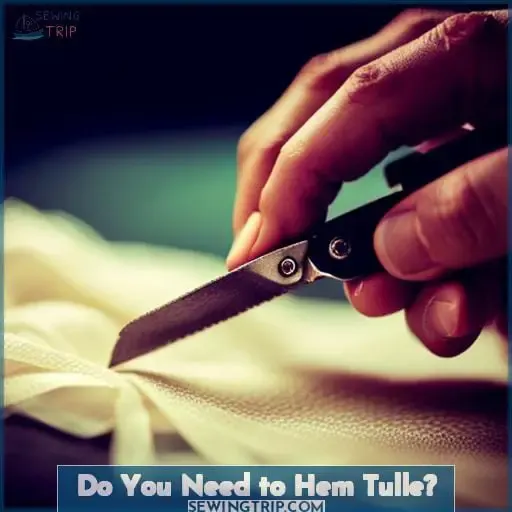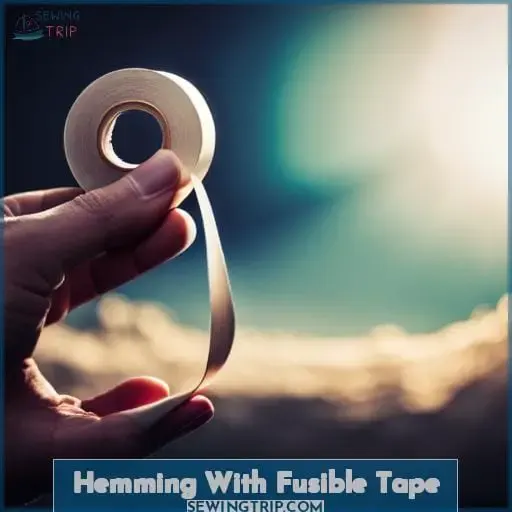This site is supported by our readers. We may earn a commission, at no cost to you, if you purchase through links.
Altering tulle is an art form, but it isn’t as daunting as it may seem. Whether you’re looking for tips on how to shorten a wedding dress or just want to know how to hem a prom dress without sewing, this article has got you covered.
From understanding the basics of altering tulle fabric and cutting dresses down to size, all the way through creating permanent hems with fusible adhesive – we’ll show you exactly what steps are necessary for perfect results every time.
And if that weren’t enough, we’ll teach you some very helpful tricks and techniques so that even those who don’t have access to a machine can still achieve stunning results when hemming their own beautiful pieces of fabric made from tulle!
Table Of Contents
- Key Takeaways
- Can You Alter Tulle?
- How to Alter Tulle on a Dress
- How to Shorten a Tulle Wedding Dress
- How to Cut a Tulle Dress
- Do You Need to Hem Tulle?
- How to Hem Tulle by Hand
- How to Hem Tulle Without Sewing
- Hemming With Fusible Tape
- Hemming With Fusible Adhesive
- Hemming a Tulle Prom Dress
- Frequently Asked Questions (FAQs)
- Conclusion
Key Takeaways

- Fusible hem tapes allow for a no-sew method of hemming tulle.
- Using high-quality adhesive is important for delicate fabrics like tulle.
- Spraying the fabric with water reduces static electricity when using a sewing machine on tulle.
- Hemming tulle without sewing is possible using techniques like fusible tape.
Can You Alter Tulle?
You can certainly alter tulle without using a needle and thread – in fact, over 95% of people who work with this delicate fabric choose to do so! Temporary hemming is one way that you can make quick alterations.
Hand sewing is often used for heavier fabrics, but it’s not necessary when working with tulle.
To get the best result when altering your tulle dress, it’s important to choose the right fabric choice for your project. Bias tape or ribbon hemming are two popular options as they help provide support while still allowing flexibility within the garment.
A rotary cutter or serger blade should be used if you need a straight edge finish on any hemlines; however, sticky tape such as fusible tape or adhesive strips may also be suitable depending on how much structure you want from your hemline overall design.
Hem tapes are great for creating curved edges and providing an extra layer of protection against fraying due to wear and tear over time.
The same rules apply whether shortening skirts, sleeves, or necklines – simple cuts paired with either bias binding, hem tapes, or ribbons offer up finished items that look just like they were made professionally!
How to Alter Tulle on a Dress
Altering a tulle dress requires careful preparation and the right materials for an effortless result. To begin, it’s recommended to add boning to the bodice or waistline as it provides extra structure and support.
Using seam binding around hems can also help prevent fraying of delicate tulle fabric. Additionally, using transparent tape on the presser foot will keep any layers from shifting or snagging when sewing with wide zigzag stitches.
If you’re working with embroidered tulle, it’s best to use bias tape to hem edges instead of ribbons, as ribbons are more suited for lighter fabrics.
For circular hems such as sleeves and skirts that require cutting before altering, you can use either a rotary cutter or serger blade to get clean cuts quickly. Afterward, restitch the seams using matching threads in wider than normal stitches to prevent them from pulling through easily over time.
If you’d like to skip hand stitching altogether, fusible hem tapes are great alternatives. Simply stick them onto the desired areas following the instructions provided with your product purchase.
Finally, steam pressing prior to starting alterations helps give wedding dresses their shape back after shortening.
- Adding boning provides extra structure and support.
- Use seam binding around hems.
- Transparent tape prevents layers from shifting or snagging.
- Fusible hem tapes allow you to skip hand stitching.
How to Shorten a Tulle Wedding Dress
Now that you have the right materials and techniques for altering a tulle dress, it’s time to shorten it!
Start by steam pressing or ironing the dress before adding length.
Using safety pins, attach seam binding around the edge of each hem. This will provide extra support when sewing.
Make sure to mark each hem slightly longer than desired so that any gathered material can be accounted for later on.
Next, use either a rotary cutter or serger blade to cut away excess fabric at each hemline.
Afterward, restitch all seams using straight stitches in matching threads, but wider than normal.
To finish off your creation without hand stitching involved, consider using bias tape along with fusible tapes such as Heat n Bond Hem Tape.
Alternatively, you can use an adhesive product like Aleene’s Fast Grab Tacky Glue. Both are perfect solutions if you decide not to sew a rolled-hem finish line onto your garment piece(s).
Finally, press down firmly on hems after adhering them, and voila – you now have your shortened wedding dress ready just in time for its big day debut!
How to Cut a Tulle Dress
Take your dress to the next level by cutting tulle with precision and ease! With a few simple tools, you can create intricate patterns and designs that will make any garment look unique.
For hand-basting thread work around a large needle, it is important to use thick thread for support when sewing tulle fabric. Additionally, using wide zigzag stitches on the machine or serger blade helps keep edges from fraying over time.
For more detailed projects such as embroidered tulle or hems with ribbon accents, there are some additional steps involved:
- Use a rotary cutter to cut away excess material at each hemline; this ensures accuracy in measurement so no extra length is added after finalizing the design of your garment piece(s).
- Hand basting may be necessary if working with multiple layers of fabric; pinning them together securely holds everything in place while stitching up seams accurately along edge lines without shifting or snagging.
- Finally, Jess Faraday recommends double fold bias tape for hemming fragile fabrics like embroidered tulle due to its lightweight structure and easy application technique which results in clean finished edges every time without having to sew!
Following these tips will ensure all garments turn out as professional quality pieces worthy of showcasing confidently on any special occasion event day celebration – whether it’s an extravagant wedding gown fit for royalty or something simpler yet still elegant like prom dresses made out of beautiful materials like chiffon & lace adorned delicately by modern trims & laces.
Do You Need to Hem Tulle?
You may not need to hem tulle fabric depending on the desired look. For example, if you want a more rustic style for your wedding dress, leaving the edges of your tulle skirt unhemmed can give an airy and romantic effect.
However, if you’re looking for something that looks polished and professional, then it might be worth considering other options such as using ribbon or bias tape to finish off the edge of your garment.
Rotary cutting is also a great way to get precise measurements with minimal effort. All you need to do is draw up your pattern first before taking scissors/blade into action.
Additionally, hand sewing can often provide more intricate details than machine work. So having both options available makes life easier when trying to accomplish specific tasks associated with larger scale projects, such as creating custom prom gowns from start to finish within a short amount of time (and budget).
Regardless of the technique chosen, it ultimately depends upon individual preferences. However, regardless of the decision made, it will ensure the end result turns out beautiful every single time, no matter how much hard work you put into it beforehand.
How to Hem Tulle by Hand
Hand basting or pinning the layers together is essential for creating a polished and professional look when hemming tulle, so let’s get crafting!
To start, make sure to have all of your supplies handy – from pincushion techniques with pins to bias tape and fusible adhesive. A pair of shears is also an important tool for trimming excess fabric after you reach your decision point.
Once everything’s ready, take it one step at a time. Start by hand-basting along the edge of the garment in order to keep each layer lined up correctly as you work through this process. Then use either a rolled hem stitch or serger stitching method to create secure hems around edges that won’t stretch out over time.
Finally, if desired, finish off with easy rolled hems using two-sided bond tape. This will help ensure no fraying happens during wear.
No matter what technique you choose, be sure not to rush since proper preparation yields beautiful results every single time! Plus, taking breaks can help rejuvenate creative juices needed while tackling such labor-intensive tasks like these.
How to Hem Tulle Without Sewing
Are you looking for a convenient and quick fix to hem your tulle fabric without the intimidation of using a machine? Maybe you lack confidence in your sewing skills or just need something temporary. Either way, there are various ways that don’t require any stitching at all when it comes to hemming this delicate fabric.
No Machine
Let your creativity flow and enjoy the challenge of hemming tulle without a machine! No-sew methods, such as fabric adhesive or bias tape, can be used. Ribbon hemming offers an elegant finish, and fabric glue is great for trimming edges.
Start by folding the tulle at the desired length, then measure with a measuring tape to check accuracy.
Quick Fix
Make a quick and easy alteration on any fabric with tulle – no sewing required! Try no-sew methods like bias tape, ribbon hemming, or fabric adhesive. Prepare the tulle by spraying it with water to reduce static electricity. Follow directions from your tape manufacturer for temporary fixes or use types of glue that won’t damage the material.
Lack of Confidence
If you’re not feeling confident about tackling the alteration of tulle, there are several ways to achieve a neat finish without using needles and thread. Overcome fear with practice and a positive attitude – try wide zigzag stitches for strength or use the tape manufacturer’s directions to attach the hem securely without a locking mechanism.
A square hem is another great option; just measure the bottom edge of your new hem, then press it firmly in place! With the right materials at hand, creating beautiful alterations on any fabric doesn’t have to be daunting.
Temporary Solution
For a quick fix, try using fusible tape or adhesive to temporarily keep your tulle in place without any needle and thread hassle. Step 1 – fold the fabric along a horizontal line at the desired dress hem length.
Step 2 – cut away excess fabric along the fold line until it meets with the dress hemline. Step 3 – apply fusible tape or adhesive directly onto the folded edge of tulle for a secure hold; press firmly into place.
Hemming With Fusible Tape
If you’re looking for a quick fix to hem tulle without having to sew, fusible tape is an excellent solution. For those who lack confidence in their sewing skills or need something temporary, this method of hemming is perfect.
Fusible adhesive can be used on various types of tulle dresses, and it creates a secure bond with the fabric that won’t come undone easily.
The first step before using fusible tape is to mark your desired length at the bottom edge for an unfinished hem look. Then simply apply strips of fusible tape along both edges of where your marked line will be sewn up later on if necessary.
Lastly, use an iron set at medium heat and press down firmly over each strip until they have all been secured onto the special fabric – voila! You now have neat and tidy hemlines without all the fussing around with thread and needlework – great job!
Hemming With Fusible Adhesive
You can easily create a neat finish on your tulle garment with fusible adhesive, no sewing required! For those who are looking for a quick fix or temporary solution to hemming without having to sew, fusible tape is an excellent option.
You will need the following items:
- Fusible Tape
- Iron Set at Medium Heat
- Marker for Hem Line Length
- Fabric Scissors or Rotary Cutter
Simply start by marking your desired length and apply strips of fusible tape along both edges of where you marked the line. It’s important not to stretch out any part as you’re applying it; otherwise, it won’t hold together properly when finished.
Once done with that step, press down firmly over each strip using an iron set at medium heat until all have been secured onto the fabric – perfect!
This method gives off a clean cut look but does require extra wear and tear because of its lack in durability compared to hand sewing methods if needed later on down the road.
To add some extra security when working with delicate fabrics like tulle, make sure to use high-quality adhesive so that your lovely gown stays intact even after multiple washes and wears.
Hemming a Tulle Prom Dress
Creating a stunning hem for your tulle prom dress doesn’t have to be complicated; with the right adhesive, you can easily transform it into something extraordinary! Start by pressing down the ethereal fabric and pinning it in place.
This is an optional step, but it will make sure your shorter hem stays in place while working on it.
A rolling hem is great for this type of project. Simply fold over one edge twice and use fusible tape to secure it together. For a more decorative look, try using bias tape or ribbon hems instead of regular sewing pins.
For those looking for an alternative method without having to sew at all, fusible adhesive works well too. Simply cut off excess material before applying strips along both edges of where you want the line marking lengthwise from top to bottom.
The final result should give off a clean-cut finish that looks almost as good as hand stitching would’ve been if done properly.
Frequently Asked Questions (FAQs)
How much tulle do I need to buy for my dress?
To determine how much tulle you need for your dress, consider the desired length and fullness. Measure from the desired hemline to waist level. Multiply this number by two or three, depending on how voluminous you want it to be.
Can I use a sewing machine to hem tulle?
You can use a sewing machine to hem your tulle. Use wide zigzag stitches and thick thread, plus a large needle for best results. Make sure you spray the fabric with water first to reduce static electricity, and put transparent tape on the presser foot to avoid snagging or shifting.
Are there any special tools I need to hem tulle?
You don’t need any special tools to hem tulle – just safety pins, transparent tape, seam binding, thick thread, and a large needle. To get the best results, hand-sew wide zigzag stitches or use fusible tape or adhesive.
How do I attach ribbon to the hem of tulle?
Securely attach ribbon to the hem of your tulle by hand sewing or using fusible tape. Hand stitch around the edges, folding and pressing as you go for a neat finish. Alternatively, adhere with adhesive for an effortlessly chic look.
What is the best way to attach bias tape to tulle?
To attach bias tape to tulle, prepare the fabric by steaming or pressing it. Secure the layers together with pins or basting stitches.
Conclusion
No matter what your experience level is with fabric and alteration techniques, hemming tulle can be a daunting task. But with the right techniques and materials, it doesn’t have to be! From hand-stitching to using fusible tape, there’s a way to make your tulle look as if it were tailored by a professional.















